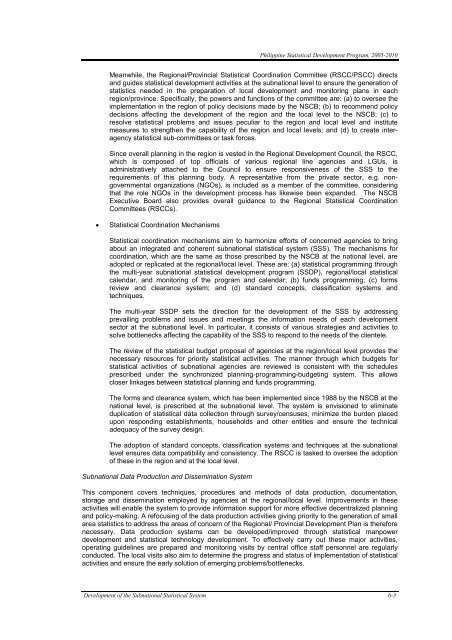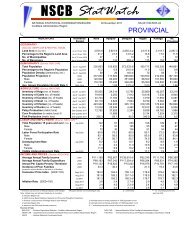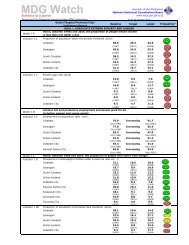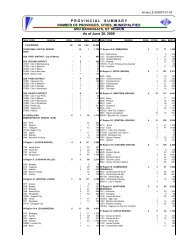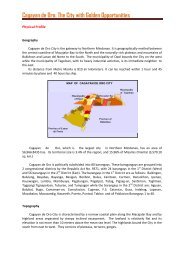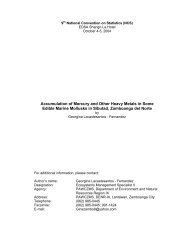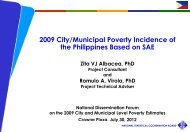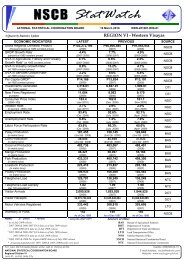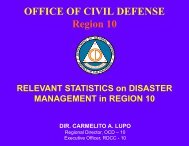chapter 6 development of the subnational statistical system - NSCB
chapter 6 development of the subnational statistical system - NSCB
chapter 6 development of the subnational statistical system - NSCB
- No tags were found...
You also want an ePaper? Increase the reach of your titles
YUMPU automatically turns print PDFs into web optimized ePapers that Google loves.
Philippine Statistical Development Program, 2005-2010Meanwhile, <strong>the</strong> Regional/Provincial Statistical Coordination Committee (RSCC/PSCC) directsand guides <strong>statistical</strong> <strong>development</strong> activities at <strong>the</strong> <strong>subnational</strong> level to ensure <strong>the</strong> generation <strong>of</strong>statistics needed in <strong>the</strong> preparation <strong>of</strong> local <strong>development</strong> and monitoring plans in eachregion/province. Specifically, <strong>the</strong> powers and functions <strong>of</strong> <strong>the</strong> committee are: (a) to oversee <strong>the</strong>implementation in <strong>the</strong> region <strong>of</strong> policy decisions made by <strong>the</strong> <strong>NSCB</strong>; (b) to recommend policydecisions affecting <strong>the</strong> <strong>development</strong> <strong>of</strong> <strong>the</strong> region and <strong>the</strong> local level to <strong>the</strong> <strong>NSCB</strong>; (c) toresolve <strong>statistical</strong> problems and issues peculiar to <strong>the</strong> region and local level and institutemeasures to streng<strong>the</strong>n <strong>the</strong> capability <strong>of</strong> <strong>the</strong> region and local levels; and (d) to create interagency<strong>statistical</strong> sub-committees or task forces.Since overall planning in <strong>the</strong> region is vested in <strong>the</strong> Regional Development Council, <strong>the</strong> RSCC,which is composed <strong>of</strong> top <strong>of</strong>ficials <strong>of</strong> various regional line agencies and LGUs, isadministratively attached to <strong>the</strong> Council to ensure responsiveness <strong>of</strong> <strong>the</strong> SSS to <strong>the</strong>requirements <strong>of</strong> this planning body. A representative from <strong>the</strong> private sector, e.g. nongovernmentalorganizations (NGOs), is included as a member <strong>of</strong> <strong>the</strong> committee, consideringthat <strong>the</strong> role NGOs in <strong>the</strong> <strong>development</strong> process has likewise been expanded. The <strong>NSCB</strong>Executive Board also provides overall guidance to <strong>the</strong> Regional Statistical CoordinationCommittees (RSCCs).• Statistical Coordination MechanismsStatistical coordination mechanisms aim to harmonize efforts <strong>of</strong> concerned agencies to bringabout an integrated and coherent <strong>subnational</strong> <strong>statistical</strong> <strong>system</strong> (SSS). The mechanisms forcoordination, which are <strong>the</strong> same as those prescribed by <strong>the</strong> <strong>NSCB</strong> at <strong>the</strong> national level, areadopted or replicated at <strong>the</strong> regional/local level. These are: (a) <strong>statistical</strong> programming through<strong>the</strong> multi-year <strong>subnational</strong> <strong>statistical</strong> <strong>development</strong> program (SSDP), regional/local <strong>statistical</strong>calendar, and monitoring <strong>of</strong> <strong>the</strong> program and calendar; (b) funds programming; (c) formsreview and clearance <strong>system</strong>; and (d) standard concepts, classification <strong>system</strong>s andtechniques.The multi-year SSDP sets <strong>the</strong> direction for <strong>the</strong> <strong>development</strong> <strong>of</strong> <strong>the</strong> SSS by addressingprevailing problems and issues and meetings <strong>the</strong> information needs <strong>of</strong> each <strong>development</strong>sector at <strong>the</strong> <strong>subnational</strong> level. In particular, it consists <strong>of</strong> various strategies and activities tosolve bottlenecks affecting <strong>the</strong> capability <strong>of</strong> <strong>the</strong> SSS to respond to <strong>the</strong> needs <strong>of</strong> <strong>the</strong> clientele.The review <strong>of</strong> <strong>the</strong> <strong>statistical</strong> budget proposal <strong>of</strong> agencies at <strong>the</strong> region/local level provides <strong>the</strong>necessary resources for priority <strong>statistical</strong> activities. The manner through which budgets for<strong>statistical</strong> activities <strong>of</strong> <strong>subnational</strong> agencies are reviewed is consistent with <strong>the</strong> schedulesprescribed under <strong>the</strong> synchronized planning-programming-budgeting <strong>system</strong>. This allowscloser linkages between <strong>statistical</strong> planning and funds programming.The forms and clearance <strong>system</strong>, which has been implemented since 1988 by <strong>the</strong> <strong>NSCB</strong> at <strong>the</strong>national level, is prescribed at <strong>the</strong> <strong>subnational</strong> level. The <strong>system</strong> is envisioned to eliminateduplication <strong>of</strong> <strong>statistical</strong> data collection through survey/censuses, minimize <strong>the</strong> burden placedupon responding establishments, households and o<strong>the</strong>r entities and ensure <strong>the</strong> technicaladequacy <strong>of</strong> <strong>the</strong> survey design.The adoption <strong>of</strong> standard concepts, classification <strong>system</strong>s and techniques at <strong>the</strong> <strong>subnational</strong>level ensures data compatibility and consistency. The RSCC is tasked to oversee <strong>the</strong> adoption<strong>of</strong> <strong>the</strong>se in <strong>the</strong> region and at <strong>the</strong> local level.Subnational Data Production and Dissemination SystemThis component covers techniques, procedures and methods <strong>of</strong> data production, documentation,storage and dissemination employed by agencies at <strong>the</strong> regional/local level. Improvements in <strong>the</strong>seactivities will enable <strong>the</strong> <strong>system</strong> to provide information support for more effective decentralized planningand policy-making. A refocusing <strong>of</strong> <strong>the</strong> data production activities giving priority to <strong>the</strong> generation <strong>of</strong> smallarea statistics to address <strong>the</strong> areas <strong>of</strong> concern <strong>of</strong> <strong>the</strong> Regional/ Provincial Development Plan is <strong>the</strong>reforenecessary. Data production <strong>system</strong>s can be developed/improved through <strong>statistical</strong> manpower<strong>development</strong> and <strong>statistical</strong> technology <strong>development</strong>. To effectively carry out <strong>the</strong>se major activities,operating guidelines are prepared and monitoring visits by central <strong>of</strong>fice staff personnel are regularlyconducted. The local visits also aim to determine <strong>the</strong> progress and status <strong>of</strong> implementation <strong>of</strong> <strong>statistical</strong>activities and ensure <strong>the</strong> early solution <strong>of</strong> emerging problems/bottlenecks.Development <strong>of</strong> <strong>the</strong> Subnational Statistical System 6-3


